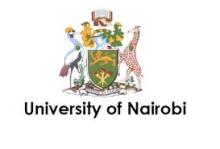Resource information
The distribution of Trichoderma species in soils of
Embu and Taita benchmark sites in Kenya with
relation to land use practices was investigated. The
study areas were chosen because of their significant
land use intensification and for being biodiversity hot
spots. Soil washing and dilution plate techniques were
used to recover Trichoderma spp from the soil samples
collected from different land use types. The fungal
isolates were identified and assigned to nine species
from Embu soils and eleven species from the Taita
soils. Greater populations were observed in Embu than
in Taita. Geographic differences between the regions
explained the differences in ecological niches of the
two regions that result to different soil assemblages
and plant types in the regions and therefore variation
in available substrate for the fungus. Land use at each
site affected the distribution, richness and abundance
of Trichoderma with napier grass having the highest
abundance in both Embu and Taita while coffee had
the lowest richness and abundance. Trichoderma
favoured plants with shallow and widely spreading
rooting systems, compared to the deeply rooted
perennial coffee and tea trees. This underpins the
importance of plant type and in effect land use system
in the abundance of Trichoderma. The unevenness in
the distribution of Trichoderma within the LUTs
suggested that other factors influenced the distribution
of Trichoderma apart from the LUTs. Unevenness was
greater in Embu than in Taita. The differences could
mostly be attributed to soil management practices
employed by different farmers while managing their
land and crops. Trichoderma harziunum was the most
frequently isolated species and the most abundant in
both Embu and Taita. Presence of Trichoderma
species in some land use types and absence in others,
provided a clue on the most preferred habitats, plants
and/or crops. Considering the beneficial aspects of
Trichoderma such as being antagonistic to the
pathogenic fungi, crops or plants such as napier grass
that induce high abundance and richness of Trichoderma can be used in crop rotations or in
combinations with other crops to maintain high levels
of the fungus in the soil.


